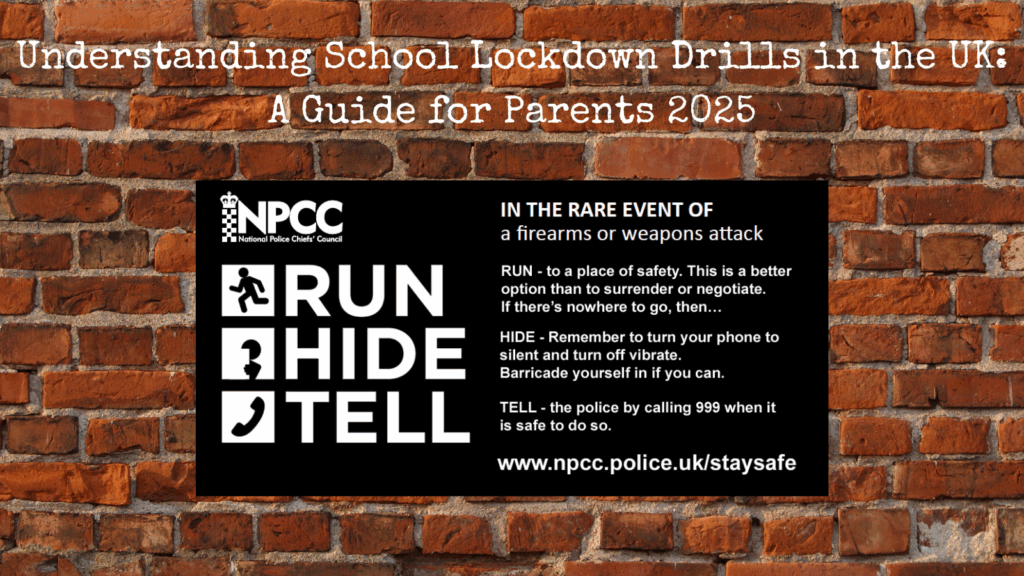In recent years, you may have heard about lockdown drills in UK schools, perhaps prompting questions about their purpose, necessity, or whether they’re a new phenomenon. This article aims to clarify what lockdown drills are, why they exist, their legal basis, and how they’re implemented, addressing common concerns among parents. While some perceive these drills as a recent development, they’ve been part of school safety planning for over a decade. Below, I break down the key aspects to help you understand this important topic.

What Are Lockdown Drills?
Lockdown drills are practice exercises designed to prepare schools for emergencies that require securing the premises, such as an intruder, a terrorism threat, or a nearby incident like a chemical spill. During a lockdown, pupils and staff may be required to stay in classrooms, lock doors, close blinds, and remain quiet until the situation is resolved. These drills aim to ensure schools can respond quickly and effectively to protect everyone on site.
The Department for Education (DfE) describes lockdown procedures as part of a broader security plan, alongside evacuation (leaving the building) and invacuation (Invacuation is a safety procedure where people move to a safer location within a building, rather than evacuating the premises, in response to an external threat). Drills help staff and, pupils practice these procedures to build confidence and preparedness.
Are Lockdown Drills Mandatory?
While lockdown drills are not explicitly mandated by law as a standalone requirement, they are strongly recommended by the DfE as part of schools’ legal obligations to ensure safety. Schools in the UK are subject to several legal frameworks that underpin the need for such preparedness:
- Health and Safety at Work etc. Act 1974: Schools must ensure the safety of pupils and staff, which includes preparing for emergencies. Lockdown procedures fall under this duty.
- Keeping Children Safe in Education: This statutory guidance requires schools to have robust safeguarding measures, including emergency response plans.
- Terrorism (Protection of Premises) Act 2025 (Martyn’s Law): Enacted in April 2025, this law requires schools with 200 or more people to develop public protection procedures, including lockdown, evacuation, and communication plans. Schools have until April 2027 to comply fully, but many are already aligning with these requirements.
The DfE’s “School and college security” guidance (updated July 2024) advises schools to have a lockdown procedure and practice it regularly. However, the specifics, such as frequency or whether pupils participate are left to school leaders’ discretion, tailored to the school’s context and pupils’ needs. For example in an SEN school, staff may have protocol to follow and it may be to alarming and distressing to have drills with students, so the staff would ensure the pupils safety. Parents can ask their school about specific policies.
How Long Have Lockdown Drills Been Happening?
Despite some parents perceiving lockdown drills as new, they are not a recent introduction. The DfE has included lockdown procedures in its school security guidance since at least 2017, building on earlier recommendations for emergency preparedness. These measures were further emphasised after high-profile incidents, such as the 2017 Manchester Arena attack, which led to the development of Martyn’s Law. Schools have been encouraged to practice lockdown, evacuation, and invacuation procedures for over a decade, often in consultation with local police. The perception that drills are new may stem from:
- Increased visibility due to Martyn’s Law and recent incidents, like the February 2025 Sheffield stabbing, which highlighted school security needs.
- Social media discussions on platforms like X, where parents express surprise or concern, sometimes linking drills to broader issues like terrorism or immigration.
- Varying implementation: Not all schools conduct drills regularly or involve pupils, so when they do, it may feel novel to parents.
How Are Lockdown Drills Conducted?
The DfE does not prescribe a one-size-fits-all approach to lockdown drills, allowing schools to tailor procedures to their specific risks and pupil demographics. Key features include:
- Planning: Schools develop a security lockdown plan, often with input from local police (e.g., Designing Out Crime Officers). The DfE provides a Lockdown template to guide this process.
- Practice: Drills may involve staff only or include pupils, depending on the school’s context. For example:
- Secondary schools may conduct full drills with pupils to simulate real scenarios.
- Primary schools and early years settings often limit drills to staff to avoid distressing young children.
- Adaptations: Schools consider pupils with special educational needs and disabilities (SEND), ensuring procedures are accessible and supportive.
- Frequency: The DfE recommends regular practice but does not mandate a specific schedule. Some schools conduct drills annually, while others do so more frequently based on their risk assessment.
Drills are designed to be age-appropriate and avoid causing undue fear. For instance, primary schools may frame exercises as games or use neutral language to explain safety measures.

Why Are Lockdown Drills Important?
Lockdown drills prepare schools for rare but serious threats, ensuring staff and pupils know how to respond calmly and efficiently. Benefits include:
- Enhanced safety: Practicing procedures reduces panic and confusion during real emergencies.
- Staff preparedness: Teachers and support staff gain confidence in managing crises.
- Compliance with upcoming laws: Drills align with Martyn’s Law, which will require schools to have robust protection plans by 2027.
- Community reassurance: Well-prepared schools can reassure parents that safety is a priority.
The DfE emphasises that while threats like terrorism are rare, preparedness is a prudent measure, similar to fire drills, which have long been standard practice.
Addressing Parental Concerns
Some parents may worry that lockdown drills frighten children or signal an increase in threats. Schools are encouraged to communicate openly about:
- Purpose: Explain that drills are precautionary, like fire drills, and aim to keep everyone safe.
- Age-appropriate approaches: Assure parents that drills are tailored to avoid distress, especially for younger children.
- Transparency: Schools should inform parents about their lockdown procedures and any planned drills, addressing concerns proactively.
If you’re concerned, contact your child’s school to ask about their specific lockdown policy and how they ensure pupil well-being during drills.
What Can Parents Do?
To support your child and stay informed:
- Talk to your school: Ask about their lockdown procedures and how they’re communicated to pupils.
- Discuss with your child: For older children, explain that drills are like practicing for safety, similar to crossing the road carefully.
- Stay informed: Review the DfE’s guidance or contact your local police for community safety resources.
- Provide feedback: Share any concerns with school leaders to ensure procedures meet community needs.
Conclusion
Lockdown drills in UK schools are not new but have been part of safety planning for over a decade, driven by evolving guidance and legal requirements like Martyn’s Law. They are strongly recommended to meet health, safety, and safeguarding duties. Schools have flexibility to tailor drills, ensuring they are effective and sensitive to pupils’ needs. By understanding the purpose and history of lockdown drills, parents can feel confident that schools are taking proactive steps to keep children safe in an unpredictable world.
References
- Department for Education. (2024, July 12). School and college security. GOV.UK. https://www.gov.uk/government/publications/school-and-college-security/school-and-college-security Safeguarding responsibilities and the legal obligations under the Health and Safety at Work Act 1974 (HASAWA) and the Management of Health and Safety at Work Regulations 1999 (MHSWR).
- Home Office. (2025, April 3). Terrorism (Protection of Premises) Bill. GOV.UK. https://www.gov.uk/government/collections/terrorism-protection-of-premises-bill-2024
- Department for Education. (2024). Keeping children safe in education. GOV.UK. https://www.gov.uk/government/publications/keeping-children-safe-in-education–2
- Health and Safety Executive. (1974). Health and Safety at Work etc. Act 1974. Legislation.gov.uk. https://www.legislation.gov.uk/ukpga/1974/37
- Ofsted. (2025). School inspection handbook. GOV.UK. https://educationinspection.blog.gov.uk/
- Department for Education. (2019). Developing a school security policy. GOV.UK. (Note: Archived content; refer to 2024 guidance for current recommendations). https://www.gov.uk/government/publications/school-and-college-security
- Home Office. (2025). Martyn’s Law factsheet. GOV.UK. https://humanfocus.co.uk/blog/what-does-martyns-law-mean-for-schools/ What Does Martyn’s Law Mean for Schools? https://www.gov.uk/government/publications/terrorism-protection-of-premises-bill-2024-factsheets/terrorism-protection-of-premises-bill-scope-premises
- Site security guidance Updated 12 July 2024 https://www.gov.uk/government/publications/school-and-college-security/site-security-guidance
- DfE publish ‘Protecting security and preparedness for education’ guidance 18 June 2025 https://www.hcrlaw.com/news-and-insights/dfe-publish-protecting-security-and-preparedness-for-education-guidance/
- School Lockdown Procedures NASUWT https://www.nasuwt.org.uk/advice/health-safety/school-lockdown-procedures.html
- ACT https://www.counterterrorism.police.uk/what-you-can-do/
